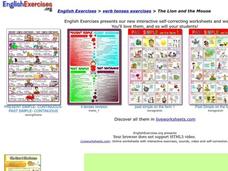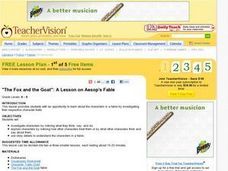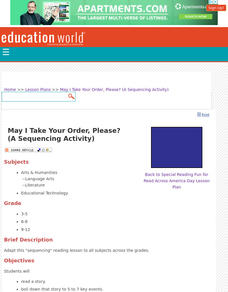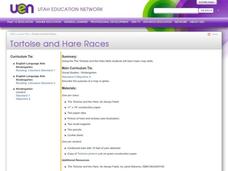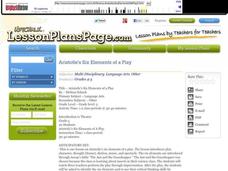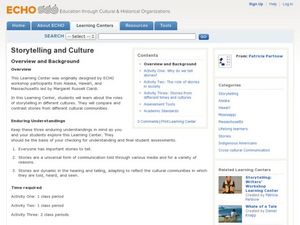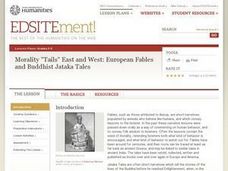Curated OER
Acting Like a Bunch of Animals: Fables and Human
The video "The Tales of Aesop" traces for viewers the history of fables and identifies their characteristics. The class then goes to the web site "The Fisherman and the Little Fish" where they examine the classic and a modern version of...
Curated OER
Tortoise and Hare Races
Students listen to the fable, The Tortoise and the Hare, and participate in various map skill activities. They manipulate magnetic tortoises and hares on metal cookie sheets to practice direction, and construct racing tortoises out of...
Curated OER
J. Paul Getty Museum Education Staff
Students will examine a manuscript page from a Flemish bestiary and discuss how it was used to teach ideas about Christianity. In this Christianity lesson plan students study the given manuscript and then compare the stories from the...
Curated OER
Aesop’s Fables Comparison Worksheet
In this Aesop's Fables comparison activity, students list the name of the fable, its characters, a story summary, and the moral of the story. They compare 6 fables.
Curated OER
Technology-commected Folklife Lesson Plan: Fables
Learners discuss ways the stories were alike and different. The teacher demonstrate how to draw a Venn diagram using Microsoft Word. They label the two circles and enter the likenesses and differences on the diagram.
Curated OER
The Lion and the Mouse
For this language arts worksheet, students fill in the blanks to sentences, complete multiple choice questions, answer short answer questions, and more for the story The Lion and the Mouse. Students complete 5 exercises.
Curated OER
Reading Exercises: "The Lion and the Mouse"
In this reading exercise online worksheet, students watch a YouTube video of the "The Lion and the Mouse." They use the drop down menu at the end of each of 9 sentences to tell if the sentence is from the story or not. They check their...
Curated OER
The Fox and the Goat
Students investigate characters' traits in a specific fable by noticing what they think, say, and do. They study key vocabulary and complete a vocabulary worksheet. They work in groups to discuss how you know if a person is kind.
Curated OER
Who's Got Game? The Lion or the Mouse?
Discuss bullying, folk tales, and more using this resource. Learners read the story The Lion and the Mouse by Toni and Slade Morrison, engage in cause and effect activities, make predictions, and discuss bullying. This is a motivating...
Curated OER
Exploring Animals in Literature
Celebrate Be Kind to Animals Week while teaching empathy and allegory with creature-related texts
Curated OER
May I Take Your Order, Please?
Pupils read a story, boil down that story to 5 to 7 key events, create a sequencing quiz to go with the story and have their classmates take the quiz. They will the strategy of sequencing by reading various stories (that they are not...
Curated OER
Helpful Animals and Compassionate Humans in Folklore
Students define elements of stories from around the world that include helpful animals. They explore animal character motivations and use graphic organizers to compare and contrast animal stories from different cultures.
Curated OER
Character Traits in Fables
Combining art, music, dance, and reading comprehension, this lesson is geared to reach all ability levels. After reading a variety of fables and discussing story elements and character traits, class members select a moral to use as the...
Weekly Story Book
Folk Tales and Fables
Pages and pages of engaging activities, worksheets, and writing projects on teaching folktales and fables await you! You don't want to miss this incredible resource that not only includes a wide range of topics and graphic...
School Specialty
The Tortoise and the Hare - Drawing Conclusions/Predictions Outcomes
Does the fastest one always win the race? Look deeper into The Tortoise and the Hare with a set of discussion questions for before, during, and after reading the story.
Curated OER
Small Actions with Big Results
Students explore philanthropy in literature. In this literature lesson plan, students read text from three different genres that all have a moral. Students compare and contrast these pieces of literature, focusing on the character traits...
Curated OER
Tortoise and Hare Races
Practice basic map skills with the story of The Tortoise and the Hare. After listening to the story, class members create a map that indicates the starting line, the path the animals took, where they stopped to rest, and the finish line....
Curated OER
Those Fabulous Fables
A video leads off this activity on fables, introducing the class to this important form of traditional storytelling. The group defines fable and hears an explanation of the origin of this type of folk tale. They summarize the story they...
Curated OER
The Coin and the Fable: Alaska quarter reverse
An Alaskan quarter and a book of fables is what you'll need to start this activity. Learners will use the image of the bear and the salmon found on the reverse side of the Alaskan quarter as inspiration. They will compose a fable about...
Curated OER
Aristotle's Six Elements Of A Play
Fifth graders view the play, The Ant and the Grasshopper. They define Aristotle's six elements of a play. At the end of the lesson, 5th graders be asked to participate in the play by acting like busy ants. This lesson would tie in nicely...
Curated OER
Storytelling and Culture
Students examine the cultural tradition of storytelling. In this storytelling lesson, students explore stories from 3 different cultures and evaluate the roles that storytelling plays in each of the cultures to pass on values and beliefs.
Curated OER
Writing Fables
Students write their own fables. For this writing fables lesson, students use handheld computers to write a fable. The class designs a spreadsheet to organize common elements of fables. Students also edit each others' work.
Curated OER
Morality "Tails" East and West: European Fables and Buddhist Jataka Tales
Have your class explore Buddhist Jataka Tales to compare and contrast them to European fables. After defining fables, Jataka tales, and the elements of each, learners identify themes and patterns for both types of narratives and the...
Curated OER
Errors vs. Rhetorical Devices
Is there a difference between writing errors and employing rhetorical devices? This presentation argues that there is a difference, but it might be a finer point than one would think. Addressing double entendre, oxymorons, and parody,...
Other popular searches
- Aesop's Fables
- Aesops Fables
- Aesop Fables
- Aesop's Fables 3rd Grade
- Aesop Fable Comprehension
- Aesop's Fables Videos
- Aesop's Fables Activities
- Aesop's Fables Worksheets
- Aesop Fables Quiz
- Aesop's Fables Unit
- Aesops Fables Unit
- Aesops Fables Powerpoint







